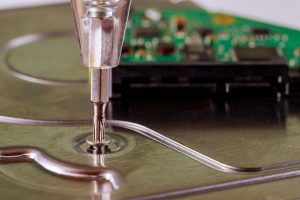Looking to get some more speed out of your old PC or Mac? A SSD upgrade might be just what your looking for!
What is an SSD or Solid State Drive?
First of all, an SSD has no mechanical parts whatsoever. If you are familiar with conventional hard drives, you may know that they read to and write from rotating magnetic platters or disks. Sort of like a CD or DVD but much faster and without the lasers. Because of the mechanical parts and the tiny areas available for reading and writing, hard drives are very fragile and slow. Usually, the hard drive is the first thing to break in a computer.
A solid-state drive, on the other hand, uses memory technology that works more like the computer’s internal memory (RAM). But unlike RAM, where information is only stored temporarily and disappears as soon as it loses power, an SSD retains its data even when your computer is turned off. In addition, it does all this without involving mechanical arms, rotating platters or anything else that could easily break.
Instead of employing decades-old magnetic storage technology, SSDs use so-called Flash memory that holds the data even if it’s not connected to a power source. You may be familiar with Flash memory from the memory cards in your digital camera or mobile phone. This is exactly what the technology is about, only a solid-state drive is a bit more complex.
The Advantages of a SSD
First and foremost, SSDs are much, much faster than hard drives. With today’s fast processors, RAM memory and other components, the hard drive has become the major weakness in a modern computer. Every time you load applications, games, or start up the operating system, the hard drive is the bottleneck that slows down operations.
Shifting to a fast SSD will bring tremendous performance benefits to any modern laptop or desktop PC, including significantly reduced startup times, faster load times, as well as speed up working with large files like pictures and video. One of the reasons for this improvement is that it can read and write to many different parts of the Flash memory simultaneously, in parallel operations.
An SSD does not have to wait for things to move (such as a mechanical arm to reach its designated area on a disk) and this gives it a huge advantage in terms of access time. The time it takes from when your computer asks for data to be read or written to that task actually taking place. To put it simply, access times are almost eliminated completely compared to hard drives.
Because an SSD doesn’t spin, it also uses less power than a regular disk, although it’s worth mentioning that portable hard drives have made great strides in power efficiency in recent years. Still, a 2.5-inch mechanical disk uses marginally more power than a solid-state drive.
Different types of SSD’s
Without going into overly complicated details, there are two types of Flash memory technologies used in SSDs. Flash memory is based on memory cells, and the most common (and most affordable) type is the MLC (Multi-Level Cell)—a technology that enables writing more data to a single cell of the drive. Then there’s the SLC (Single-Level Cell) that only writes one bit of data at a time. SLC drives are more common in servers since their performance is often better and they can withstand more writes before wearing out.
Most SSDs aimed at the consumer market is the type of MLC that wears down faster, meaning that you can’t expect your new drive to last forever. However, it will still withstand enough normal use that this is hardly a problem in the real world. Most likely it will outlast a hard drive several times over and be one of the last things to break in your computer.



